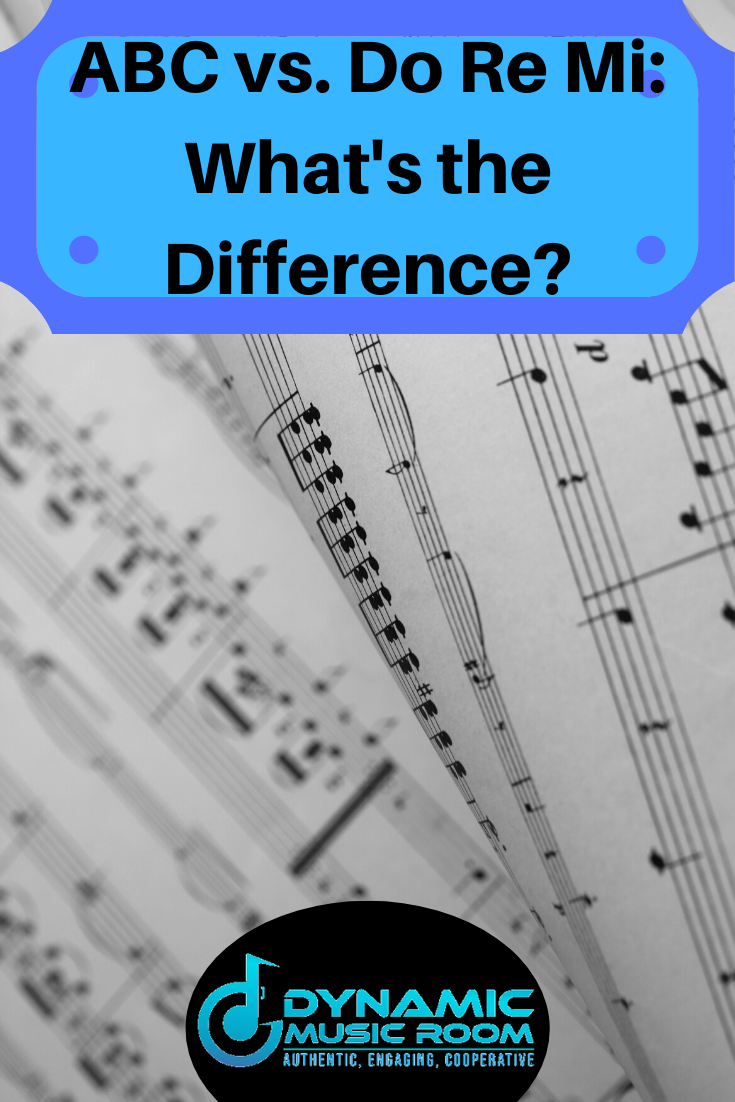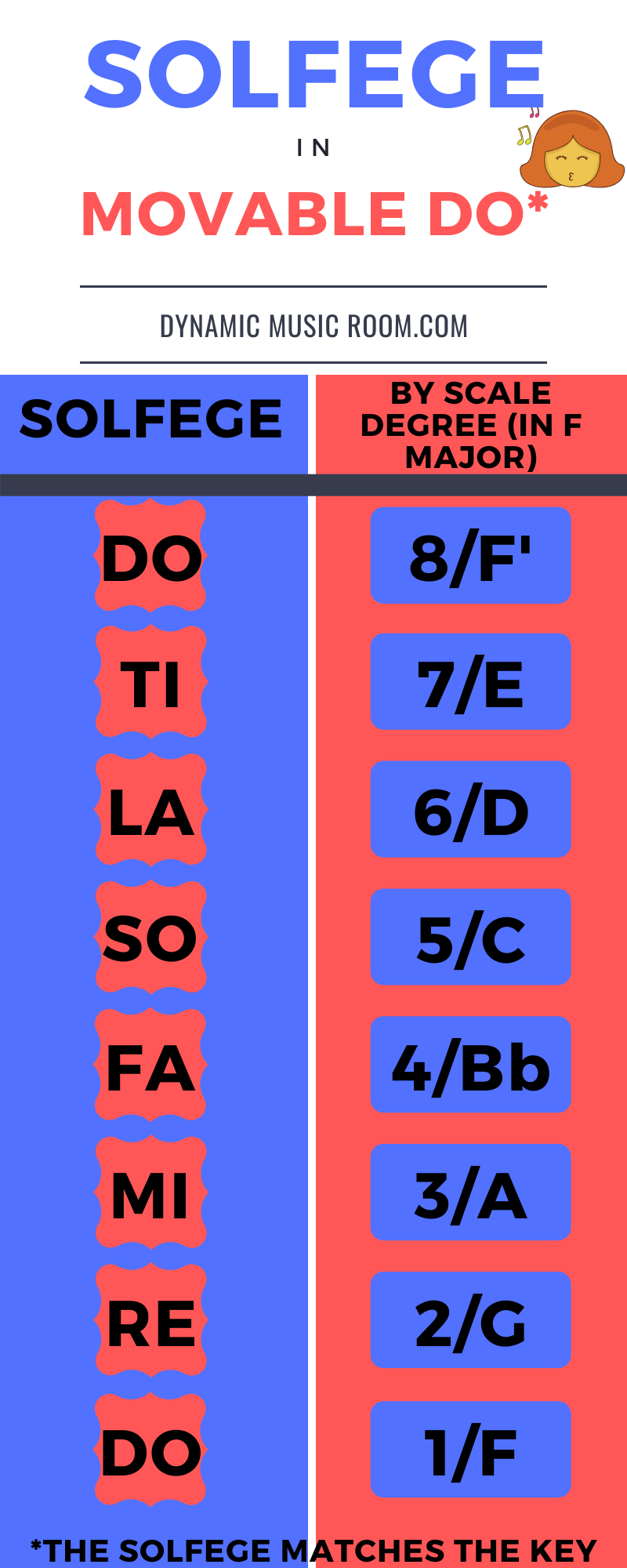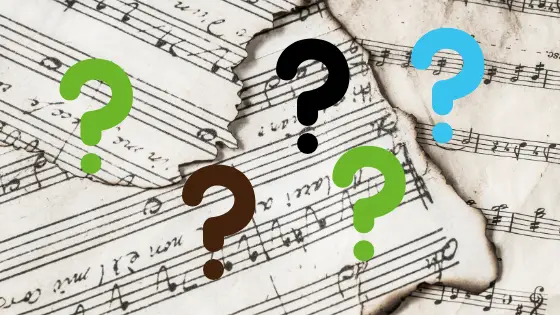Have you ever wondered why some people use do re mi and some people use a b c?
It’s a common question I get from new teachers and experienced ones alike. This is a fun (read: nerdy) topic I like digging into, so I decided to write up this ABC vs. Do Re Mi review.
ABC is what musicians call musical notation or ABC notation. These are the common letter names for specific note frequencies and where they fit on the staff. Do re mi are solfege notes which help train ears to better hear pitch relationships and intervals.
Read on for more details about the often discussed topic.

Save time with these 60 FREE Music Resources to use in your room right away!
Stop searching the whole internet to find good activities. I’ll help you cut to the chase with my favorite 60 FREE resources.
Table of Contents
What Is Do Re Mi?
First, let’s look at do re mi. These are solfege pitches based on the work of Guido de Arezzo.
Story goes, he needed help teaching his singers how to hear and read better, so he developed this solfege and a reading system based on the starting pitches and lyrics of the Latin “Hymn to Saint John the Baptist.”
Originally, they only used the syllables: ut, re, mi, fa, sol, la
Over time, it was changed to do and it was added as the leading tone.
The pitches are typically substituted for the scale degrees in the different modes.
For example, in F major:
- Do = F
- Re = G
- Mi = A
- Fa = Bb
- Sol = C
- La = D
- Ti = E
- High do = F
This is an example of a syllable system designed to help learners of all ages and ability levels better develop the aural association between different pitches and how they function in scales and with each other.
Do re mi syllables are used in most elementary music methods and most secondary and collegiate choral programs.
In the search of solfege and ear training improvement, you may want to check out a couple of these resources.
Conversational Solfege – This curriculum is perfect and sequential for elementary and early middle school students.
Sing at First Sight – This is for choirs, but it works for instrumental groups as well.
Solfege…A Comprehensive Course – This book is meant for adults or older teens. It’s not as “fun,” but it works quite well.
What Is ABC In Music?
ABC in music refers to something musicians call musical notation. Essentially, this means each of the 12 pitches (at least for traditional Western music), is given a letter based on the frequency of the pitch.
This is most often associated with the staff. Where the notes sit on the staff depends on something called the clef.
The 12 letters of ABC notation include:
- A
- A#/Bb
- B
- C
- C#/Db
- D
- D#/Eb
- E
- F
- F#/Gb
- G
- G#/Ab
This is typically used more in instrumental programs and playing.
Read more about ABC notation.

Do Re Mi Fa Sol vs ABCD
Now that you know a little more about what the two systems are, we can compare the two. Each system has its uses in developing a well-rounded musician.
Solfege
The main benefit of solfege is how it develops aural skills. Speaking from personal experience, I was never really able to look at a piece of music and instantly sing it.
I don’t have perfect pitch, but I did go through an undergraduate degree in music.
It wasn’t until I took my Kodaly training and had dedicated solfege training I felt like I improved in sight singing notation.
This benefit is available to all ages and types of musicians. The syllables are just a tool for better realizing how the pitches sound in relation to one another.
On the downside, when it comes to instruments, the solfege syllables will help hear how the notes fit together, but the technical aspect of playing an instrument lends itself more towards the ABC notation. It helps to just know “a B is fingered like this” rather than converting.
But the ear training aspect is impactful for instrumental musicians as well.
ABC Notation
Traditional musical notation or ABC notation is a great tool and necessary for the higher levels of musicianship, especially on instruments.
Knowing where and which notes are which opens up doors to complicated pieces and songs.
For instrumentalists, it’s essentially for developing technical skill and learning the longer pieces they may need to learn.
Singers would also benefit from learning these as it will help them practice in the correct key and range of the pieces they sing.
Learning only using ABC notation is limiting when it comes to hearing the true pitch relationships in music. It also makes it difficult to change keys on the fly and limits the ability to inner hair pieces before playing it.
ABC notation is not as applicable to the youngest learners as they don’t have the technical ability to play their instruments or the ear training to truly hear and understand music yet.
My Recommendation
Both are important pieces of the music puzzle.
Do re mi solfege should be used exclusively in the lower elementary to develop aural awareness.
As the students age and begin to play instruments, ABC notation should be introduced a little at a time. Starting when students learn recorder or start taking piano (around 2nd-4th grade) makes sense.
During this middle time, the emphasis should still be on solfege with ABC notation to supplement.
Once students go to secondary performance-based music, it changes again.
For choral and folk music (rock, blues, etc), the emphasis is still on solfege ear-training with a heavier dose of ABC notation than before.
For instrumental musicians, the emphasis is placed on technical skill and ABC notation. While it’s common to leave off the solfege at this point, I believe this is a mistake.
Solfege plays a smaller role in this learning, but it should still be a key part.
Do Re Mi – A B C Conversion
Converting do re mi to ABC depends on if you’re using moveable do or fixed do. In fixed do, do basically replaces the letter names and loses the flexible nature of the solfege.
Fixed do conversion:
- Do = C
- Ra = C#/Db
- Re = D
- Me (may) = D#/Eb
- Mi = E
- Fa = F
- Fi = F#/Gb
- Sol = G
- Si/Le (lay) = G#/Ab
- La = A
- Li/Te (Tay) = A#/Bb
- Ti = B
For moveable do, the solfege matches the key where do = tonic.
Here is an example of D major:
- Do = D
- Re = E
- Mi = F#
- Fa = G
- Sol = A
- La = B
- Ti = C#
- Do = D
Here is another, this time in G Major:
- Do = G
- Re = A
- Mi = B
- Fa = C
- Sol = D
- La = E
- Ti = F#
- Do = G
This infographic may help you remember.

Conclusion
I hope you enjoyed learning about ABC vs. do re mi and what the difference is. In the end, it may be better to use a combination of the two with older musicians and do re mi solfege for younger students.
Solfege is critical for improving singing and musicianship in general.
So is learning from quality teachers and great programs. If you can’t pay the high price for in-person lessons (and don’t have the time), you need to check out 30 Day Singer.
The online singing program improves everyone’s voice and has a huge amount of useful resources.


